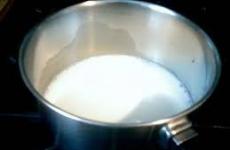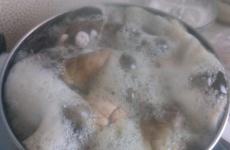How to close the gaps in the floor between the boards: cover the wooden ones, seal the holes from the mice, putty the seams with plywood. How and with what to close up cracks and holes in concrete How to close a hole in the floor with plywood
Wooden floors are characterized by high performance and decorative qualities. This is possible if all work on their device is completed without serious mistakes. Otherwise, you need to be ready for serious repairs and find out in advance how and with what to close a hole in the floor from the boards.
Causes of holes
All the variety of causes that lead to floor damage can be combined into two large groups:
- poorly executed base;
- floorboard defects.
The first group includes errors associated with lags (defective material, insufficient section), creation favorable conditions for the development of mold and fungus, poor-quality concrete base or supports.
A hole in the floor may be formed due to the destruction of the floorboards themselves. To reduce the likelihood of such a development of events, it is necessary to avoid the use of low-quality lumber.
Critical defects include:
- long through cracks;
- dead and dropping knots of considerable area;
- damage to wood by a woodworm beetle.
Coating repair
In order to understand how to repair a hole in the floor, it is necessary to assess the extent of the damage. Small areas can be repaired by replacing part of the board between two joists. Sometimes with significant damage, it can be easier to replace the entire floorboard or even several adjacent ones.
A chisel cuts off a piece of wood around the fastener until it is easily accessible. Then the fasteners are removed, depending on what was used nails or self-tapping screws, a nail puller or a screwdriver is used.
The damaged area is selected with a jigsaw, saw blade or manually using chisels. Further, with the help of a crowbar, chisels and a hammer, defective areas of the floor are removed.
The hole in the floor is covered with new, healthy boards. So that they sit on their seat as much as possible, the lower part of the groove is cut off. The board is installed in its place and attached to the lags with self-tapping screws.
Fastener caps are masked with putty.finally appearance the floor is restored after painting the repaired area.
Foundation repair
Floors of the first floor made on the ground are very critical to the quality of the preparation of the base. The concrete screed, on which the floor lags rest, is poured over pre-made layers of compacted crushed stone, hydro- and thermal insulation.

Repair of such floors begins with the removal of a wooden coating. The choice of how and with what to close holes in concrete floor made after assessing the nature and extent of damage to the rough screed.
Most often, screed repair comes down to jointing cracks and filling them with concrete mortar. Large dips are filled with compacted rubble, covered with hydro- and thermal insulation and poured cement mortar flush with subfloor level.

Tsugunov Anton Valerievich
Reading time: 5 minutes
When replacing flooring, apartment owners often have to deal with the need to repair the concrete floor, which can be either concrete or the floor slab itself. Despite the fact that concrete is a durable and reliable material, potholes and cracks can appear on it under the influence of various factors. To prevent further destruction, timely measures are necessary, because the service life of the finishing floor depends on the condition of the concrete base. Find out how to repair concrete pavement using special mixes for repairing concrete floors.
Causes of defects in concrete
Defects on the concrete floor can be formed for various reasons, which are primarily associated with violations in the process of its arrangement.
Cracks often appear due to missing, untimely cutting or incorrect calculation of the thickness of the joints in concrete floors, designed to prevent concrete stress during thermal expansion and shrinkage. Properly made temperature-shrinkage seam will avoid many problems.
Other causes of cracks include:
- a large amount of water in the solution when pouring a concrete screed or its lack;
- low-quality reinforcement;
- lack of base waterproofing.
Defects can form even with high-quality work done. Any coating is subject to natural wear and tear, it is negatively affected by excess moisture. Potholes appear due to physical influences. influence cannot be ruled out external factors on the concrete floor. The weak point is the junction of the wall and the floor, cracks often appear there.
The type of damage must be determined. This will allow you to draw up a work plan and choose desired material. Often faced with the following varieties:
- small depressions, potholes;
- cracks of various sizes;
- the thinnest cracks and chips.
Repair should not be put off for a long time. The size of the defects may gradually increase, the concrete will begin to crumble and move away in pieces, which will complicate the sealing of problem areas.
The choice of mixture for the repair of concrete surfaces
Before you start repairing the floor in the apartment with your own hands, you need to prepare a mixture for restoring concrete surfaces and structures. In building stores, they are presented in in large numbers. In order to choose the right brand of mixture, you need to determine the degree of damage to the concrete surface:
- First degree - there are shells, shrinkage cracks.
- The second degree is peeling of the surface, small chips.
- Third degree - cracks within 2 mm with a depth of not more than 40 mm.
- Fourth degree - cracks more than 2 mm, depth up to 10 cm.
- Fifth degree - large potholes and cracks, a depth of more than 20 cm.
The purpose of the repair mixture should be indicated on the packaging. Noteworthy are such manufacturers of mixtures for the restoration of concrete surfaces as Emaco, Birss, Ceresit, Bars.
You can use universal repair mixes, such as Ivsil Render.
Since the price of special thixotropic compounds containing reinforcing microfibers and polymers is quite high, the mixture can be prepared independently for a small amount of work. To do this, take 1 part of PVA glue and mix with 4 parts of water. In this solution with construction mixer or a special nozzle on the drill is kneaded sand-cement mixture in a ratio of 1:3.
Preparatory work
After choosing a material for repairing concrete floors, you should start repairing. First comes the preparatory stage:
- All foreign objects are removed from the room.
- existing trash, concrete chips and dust is swept away. Potholes and cracks are thoroughly cleaned with a vacuum cleaner.
- Any dirt, rust, mold or old soil is removed with a stiff metal brush.
- To eliminate greasy stains, you need to use a special solution.
- The concrete floor is swept with a wet broom, then it needs to be dried.
- If the reinforcement is visible, then it should be cleaned with sandpaper and primed with a composition with anti-corrosion properties.
Areas of the concrete surface that have lost strength should be hammered and cleared. The rule also applies to the edges of problem areas.
Filling holes in concrete floor
Repair of concrete floors begins with the expansion and deepening of the pothole around the perimeter. It is better to use a grinder with a diamond disc for this.
- The cut is made 1 cm deeper than the defect. To the sides, the pothole expands by 2–3 cm. If necessary, these figures are increased.
- Using a perforator or a hammer with a chisel, a notch is made in place of the pothole, a rectangular recess should be obtained. If a perforator is used, then it is better for outsiders to move away.
- The recess is thoroughly cleaned with a vacuum cleaner and primed.
- You can close up the pothole after the soil has dried. The mixture is carefully leveled, it is pierced several times to remove air. You can use a metal pin or trowel. Level the surface using the rule.
The depth of the hole matters. If it is more than 5–6 cm, then the composition is poured in several layers. The maximum layer thickness is 2 cm.
- After hardening, they proceed to grinding. A building level will help to achieve an even concrete base.
Work is recommended to be carried out in a respirator, goggles and gloves. Windows must be left open during renovations. The floor can be covered with paint on concrete, which will serve additional protection. It is selected specifically for residential premises. A floor repaired in this way will serve for a long time.
Crack Repair Rules
The process of sealing cracks in a concrete floor differs depending on their size.
- Small gaps expand in depth and width by 2–5 cm. For this, you can use a chisel or grinder.
- The recess is cleaned of pieces of concrete and dust, then processed.
- To repair cracks in the concrete floor, a home-made mixture based on PVA is used. It fills the crack and waits for shrinkage.
- A second coat is applied, dried and sanded.
In cases where the cut is accompanied by strong dusting, which indicates that the concrete is weakened, it is necessary to use only special thixotropic compounds.
Repairing cracks in concrete floors should not be put off for long. If they are deformable, then they need to be treated with special attention. You can determine their appearance using strips of paper. A few months before the repair, they are glued to cracks in the concrete floor. With shrinkage slots, the paper will remain intact, with deformation strips they will break, which indicates their expansion.
- Such a crack is sawn 5 cm deep and 3 cm wide.
- The edges of the cut are knocked off, a triangular notch is formed.
- After thorough cleaning, the recess is primed.
- Markers are inserted into the crack with a step of 3 m.
Markers are thin smooth metal rods. You can make them yourself from the spokes of a bicycle wheel.
- The crack is filled with a thixotropic compound; the use of home-made mixtures in such cases is not recommended.
- The concreted area after drying is polished.
- The marker rods are removed, a new expansion joint is cut out through the holes left after them.
- Dust is removed from the seam, and the Vilotherm cord or its equivalent is placed in it.
- The seam is finally sealed with a sealant based on silicone or polyurethane.
Some people notice small cobweb cracks on the floor, as in the next photo. Over time, they may become wider. When the concrete weakens in this part, they are cleaned and covered with soil. For embedding, you can prepare your own composition or use a store-bought one.

The appearance of cracks is one of the most pressing problems of plank floors. Floor creaking, heat leaks, dust and insect intrusion are all unpleasant consequences of such defects, and if measures are not taken in a timely manner, the floor will have to be completely changed. Meanwhile, there are several effective ways close the gaps in the floor between the boards and significantly extend the life of the coating. All of them are quite simple, they do not require special skills, and therefore everyone can do it. So, why do gaps form in the floor and how can they be eliminated?
To choose the best way to seal gaps, you first need to accurately determine and eliminate the cause of their appearance. If this is not done, the result repair work will be short-lived and after a while everything will have to be repeated again.
The following factors contribute to the occurrence of cracks:
- natural shrinkage- any wood is subject to shrinkage, only with different intensity. Boards that have been processed in vacuum chambers hardly change their geometry during their service life, but ordinary lumber can dry out by 5-10%, or even more, depending on the initial moisture content and wood species;
- low indoor humidity- if the air in the house is too dry, the boards will intensively give off moisture and decrease in size. For wooden floors, the optimum air humidity should be kept within 40-65% at a temperature of 18 to 25°C;
- incorrect installation- violation of laying technology leads to loosening of the boards, their subsidence and deformation, resulting in gaps between the floorboards. The most common mistakes are non-compliance with the plane when installing the log and weak fixation of the flooring;
- rodents living under the floor- Mice and rats are able to gnaw through the thickest boards to get into the room. The more active the pests, the more cracks and holes they will make, and it is most difficult to eliminate such damage;
- laying raw lumber- drying of the boards during the operation of the floor almost always leads to significant deformations of the flooring and the appearance of gaps between the floorboards. That is why, when choosing, it is necessary to give preference to well-dried, even boards with a relative humidity of 8-12%.



Depending on the number and size of gaps, as well as general condition wooden elements, repairs may have varying degrees complexity - from sealing individual damage to complete replacement flooring.
Troubleshooting Methods
The choice of termination method should be approached thoroughly, taking into account the cause of the damage, the location of the cracks, as well as the labor costs and time it takes to repair. Equally important is the financial aspect, because the larger the work, the more funds you will need.
| termination method | Description |
|---|---|
| It is used to eliminate small cracks and cracks in the floor. Adhesive tape is needed not simple, but reinforced, 50 mm wide. The floor is cleaned of dirt, degreased and dried, after which the gaps are sealed with adhesive tape, the edges of which are fixed to the floor with a stapler. The method is very simple and budget, takes a minimum of time. Minus: the floor with tape stripes does not look aesthetically pleasing, so carpet, carpet or other rolled covering must be laid on top |
| It is used to eliminate gaps between the floor and walls resulting from the drying of wood. It is carried out after dismantling the skirting boards and cleaning the gaps from debris and dust. If the slots are too wide, pieces of foam are placed in them before foam is blown. After the foam has dried, its excess is cut off at the level of the floorboards, the cuts are puttied so that dust does not accumulate in the pores of the material, and the skirting boards are installed back. The method is convenient, does not require much physical effort, and takes a little time. Cons: high foam costs, fragility |
| This option is suitable for small gaps between the floorboards. Only special wood putty is used. The composition is applied with a spatula, carefully filling all the recesses and gaps, after drying, the surface is polished. The method is fast, does not require special skill, and is quite affordable at a cost. The downside is fragility - putty tends to crack and crumble, especially with heavy loads on the floor |
| Homemade repair compounds are often used to seal wide gaps and cracks in the floor. Traditionally, a mixture of carpentry glue and sawdust is used, which is applied with a spatula to problem areas, tamped into recesses, and polished after drying. To seal cracks gnawed by mice, cement and broken glass are added to the adhesive solution. To speed up the curing process, epoxy is used instead of wood glue. This method of termination is very affordable and durable, moreover, it is easy to perform. |
| With wood sealant, both narrow and wide gaps between floorboards can be easily sealed. The nozzle in the form of a syringe allows you to effortlessly evenly distribute the composition and fill all the recesses. Due to its elasticity, the sealant will not come off the boards during temperature deformations and will reliably serve for more than one year. To mask the repaired areas, putty is applied over the sealant to match the color of the coating. The method is convenient, simple and durable, material costs are low |
| This method allows not only to eliminate cracks, but also to effectively get rid of squeaks in the floors. In hardware stores, a special synthetic cord of various thicknesses is sold, which is selected according to the width of the gap. Instead of a cord, you can use a regular hemp rope. To seal the defect, the cord is liberally lubricated with carpentry glue, laid on the floor and tightly hammered into the slot with a corner of the spatula so that 2-3 mm remains from the cord to the floor surface. This recess is filled with a mixture of sawdust and glue, leveled, and polished after drying. Similarly, you can use sanitary tow. The method is reliable, inexpensive, although a little laborious |
| Used to fill wide gaps in the floor. Wooden slats are hewn in the form of wedges according to the size of the gaps, thickly coated with glue and hammered into the gap with a rubber or wooden hammer. After the glue dries, the part of the wedge protruding above the floor is removed with a planer, the working surface is polished and painted. One of the most practical ways- Inexpensive and durable. Cons: trimming and fitting take extra time, some effort and skills in working with carpentry tools are required in the process |
| It is used in case of significant drying of the floorboards and the appearance of wide cracks in the floor. To do this, the boards are carefully dismantled and then laid again, compacted with wooden wedges, clamps, a jack or a special lever. As a result of tightening, additional 2-3 floorboards will be needed, depending on the degree of floor shrinkage. The method is characterized by high reliability, durability and low cost. The disadvantages include the duration of the process and its complexity. |
| It is used in cases where there are many cracks and the appearance of the floor leaves much to be desired. Plywood is laid on the floor so that there are gaps of 1-2 mm between the sheets, and the joints in each row are displaced by at least a third of the sheet. The sheets are fixed with self-tapping screws, sinking the hats into the tree, then the recesses are puttied, the flooring is polished and the finish coat is laid. This method allows not only to close all the damage, but also to insulate the floor, as well as level the base under the decorative coating. Cons: high material costs, labor intensive work |
Reinforced tape prices
reinforced tape
All the described methods have been repeatedly tested in practice and are widely used by home craftsmen. And now let's take a closer look at the most popular options for sealing gaps: what tools to use, how to properly prepare the surface and workflow technology.
Prices for silicone sealant "Moment"
sealant silicone moment
Gap sealing technology
Most often, gaps are eliminated with the help of sealants or putties, which are presented in a large assortment in hardware stores. As a more budget option, many prefer embedding with wooden wedges.
Sealing cracks with sealant
The effectiveness of this method directly depends on the type of sealant. In living quarters for wooden surfaces silicone or acrylic based formulations are used. The former have greater elasticity, and therefore better withstand the deformation of the coating when changing humidity and temperature conditions. But they publish bad smell during application and are unsuitable for subsequent staining, so that in order to mask the treated seams, it is necessary to initially buy a composition that matches the color. Acrylic sealants can be puttyed and painted, have no smell, are applied easily and quickly. Their disadvantage is the tendency to shrink and lower elasticity.
Advice. Acrylic sealant is best suited for heated rooms with little fluctuation in humidity levels. For unheated premises, or irregularly heated, it is worth choosing a silicone-based composition.

In terms of quality, Ceresit, Tytan, Moment and Bostik sealants are considered the best.

In addition to the sealant, you will need a narrow and wide spatula, a clean, dry rag and a protective impregnation, such as parquet oil, for work.

The floor is well cleaned of dirt, paying special attention to cracks. If necessary, the surface is degreased or washed with water, after which you should wait for the wood to dry completely.
Carefully cut off the tip of the nozzle along the width of the gap between the boards, insert the tip into the gap and squeeze out the sealant in an even continuous strip.


After filling the cracks in a certain area of the floor, they take a narrow spatula and level the composition by running the tool along the cracks. The trowel blade should be held at a slight angle to the surface to remove the sealant flush with the boards and not leave any projections or indentations at the seams.

Step 4 After leveling, wipe off excess mixture with a clean, dry cloth.
A small amount of parquet oil is poured onto the floor and spread over the work surface with a wide spatula. The movements of the spatula should be arcuate, across the boards, so that the protective composition fills the smallest depressions with high quality.


Now it remains only to wait for the surface to dry. If everything is done correctly, the cracks in the floor will not bother you for a long time.
Elimination of cracks with putty
What you need for work:
- putty on wood;
- wide spatula;
- Sander.
| Step, No. | Procedure |
|---|---|
| The floor is vacuumed or wiped with a well-wrung cloth to remove dirt. |
| Stir the putty and pour a small amount onto the floor. |
| With a spatula, gently spread the mixture over the floor, starting from the corner. The spatula blade is pressed firmly against the surface and drawn along the junction of the wall and floor across the floorboards. The floor is treated with wide stripes, moving from the far corner to the doors. The putty layer should be as thin as possible so that the texture of the wood shines through. The main thing here is to fill the gaps, so the putty is carefully rubbed into the gaps and recesses, and the excess is removed with a spatula. |
| After the process is completed and the putty has dried, the floor must be processed with a grinder. If the room is small, grinding can be done manually. |
| Now it remains to vacuum the floor and cover the boards with a protective compound. If there are few cracks, it is not necessary to putty the entire surface. In this case, the composition is applied with a small rubber spatula exclusively to the cracks, carefully filling all the recesses. |

Sealing a gap with a wooden lath
In the process of work you will need:
- thin wooden rail;
- a large awl or screwdriver;
- PVA glue;
- hacksaw with fine teeth;
- a hammer;
- putty on wood;
- sandpaper.
The gap between the boards and the floor surface is cleaned of dirt and dust.

The tip of a screwdriver or an awl is inserted into the slot and is forcefully drawn several times along the entire length of the board so that the rail fits more tightly into the gap.



Step 4 They take a rail, insert it with an edge into the slot and knock it out with a hammer. For convenience, the lower edge of the rail can be hemmed in the form of a wedge - so it will go deeper between the boards and fill the gap more densely.


Advice. If there is no wooden mallet, you can knock out the rail with an ordinary hammer, turning it on its side. You can also use wooden block as a lining - so on the rail there will be no dents from the hammer.
When the glue dries, the protruding part of the rail is cut off with a hacksaw flush with the surface, then cleaned with a planer.



The treated area is covered with putty to eliminate the smallest defects, then polished with fine-grained sandpaper.

After that, it remains to clean the dust and treat the boards with any protective compound - oil, varnish, stain or floor paint.
Video - How to close the gaps in the floor between the boards
How to fix a hole in the floor from the boards? What about the hole punched in the plywood flooring? How to repair a deep pothole in concrete screed or through hole reinforced concrete slab overlap?
In the article we will try to answer these questions.
The reasons
First, let's find out where a hole in the floor can come from.
Agree that the situation when the surface suddenly falls under your feet is quite unlikely.
- Falling heavy objects. A very real situation for weightlifting halls and for industrial premises with wooden flooring (which, however, is rather an exception).
Note: Platforms in sports halls are usually assembled from timber, strapped with staples. The platform is laid directly on the screed and covered with a hard rubber sheet. In general, if a fallen bar breaks through the floor, this indicates either a gross violation of building codes, or poor discipline of athletes training with big weights outside the platform.
- rotten boards. The picture is typical for houses built more than half a century ago. Harmless antiseptics were not yet available at that time, and creosote and impregnations based on petroleum products were not used in residential premises.
- cracked boards. Actually, in this case, we do not have a hole in the floor, but a gap.

- Defects in slabs and screeds due to flaws in their casting or laying. AT apartment buildings gaps between hollow core panels predominate in this category.
- Finally, holes are punched in ceilings for laying communications - during construction or overhaul. They, of course, also have to be sealed - for reasons of heat and sound insulation.
elimination
How to fix holes in a concrete floor? In the general case, it is quite logical to use the same concrete for this. More precisely, a cement-sand mixture.
Hollows in the screed
- The pothole is cleared of debris and dusted with a vacuum cleaner.
- If you have it on hand, it would be a great idea to prime the recess. This will improve adhesion to the cement-sand mortar.
- Then the pothole is filled with mortar; the surface is smoothed with a spatula, trowel or ordinary plank. The ratio of cement and sand suitable for these purposes is 1:3.
- With a large volume of potholes, you can use a backfill made of fragments of bricks, stones and rubble.
As you can see, there are no universal solutions for all occasions. Everything is determined by the cause of the problem.
You can learn a little more about floor repair from the video in this article. Good luck!
" width="640" height="360" frameborder="0" allowfullscreen="allowfullscreen">





















